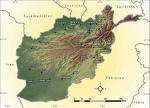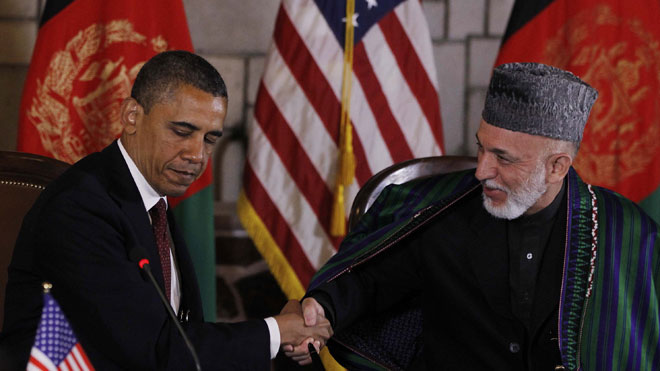Permanent US Military Bases in Afghanistan

Afghan President Hamid Karzai Thursday revealed that Washington wants to maintain nine US military bases scattered across the country after the formal deadline for the withdrawal of US and NATO coalition forces at the end of 2014.
In a speech delivered at Kabul University, Karzai stressed that he was amenable to the US demand, indicating that he was willing to trade the bases for promises of a continued flow of economic aid from the West and security for his puppet government. Another likely condition is US support for the election of his handpicked successor in an election set for next year.
“If these conditions are met, we are ready to sign the contract with the United States,” he said. As to the continued presence of foreign troops on Afghan soil after more than a dozen years of war and occupation, Karzai stated, “We see their staying in Afghanistan beyond 2014 in the interests of Afghanistan as well as NATO.”
The statements represented an abrupt rhetorical shift by the US-backed president. In recent months, Karzai has accused Washington of colluding with the Taliban to increase violence and create a pretext for a continued US military presence. He has repeatedly demanded an end to US aerial bombardments and to night raids by US Special Forces, which have claimed civilian lives and increased hatred for both the foreign occupation and Karzai’s corrupt puppet government in Kabul.
In February, Karzai barred US special operations troops from operating in the entire province of Maidan Wardak, southwest of Kabul. These and other statements and gestures have been aimed at deflecting popular hostility and posturing as a nationalist leader, rather than Washington’s stooge.
Karzai’s casting himself now as a pragmatic deal maker, however, was by no means welcomed by the Obama administration, which appeared blindsided by the Afghan president’s remarks.
US officials refused to confirm the request for nine bases, which Afghan aides to Karzai said was contained in the latest American draft proposal submitted last month.
White House spokesman Jay Carney told reporters in Washington, “The United States does not seek permanent military bases in Afghanistan, and any US presence after 2014 would only be at the invitation of the Afghanistan government and aimed at training the country’s forces and targeting the remnants of Al Qaeda.”
Carney stressed that Washington was negotiating a bilateral security agreement that “will address access to and use of Afghanistan facilities by US forces.” He reiterated three times in the course of his remarks the denial that the US was seeking any “permanent bases.”
The reality is that Washington is negotiating with its Afghan puppet regime the unrestricted use of bases that it will formally lease from Kabul for at least the next decade.
According to the Karzai regime, the bases sought include Kabul, Bagram, Mazar, Jalalabad, Gardez, Kandahar, Helmand, Shindand and Herat, placing US forces in virtually every corner of the country.
The Obama administration has said next to nothing publicly about its post-2014 plans for Afghanistan. It has no interest in placing before the American people its blueprint for continuing military operations in the country where the US has waged the longest war in its history—an intervention that is vastly unpopular with the American people. Recent polls have shown two-thirds of the US population agreeing that the war was not worth fighting.
The White House wants to maintain the myth, which it continuously promotes, that “the tide of war is receding,” and that all US forces are being brought home from Afghanistan.
Recent reports have indicated that the Pentagon brass want to keep at least 13,500 troops deployed in Afghanistan, with a large portion consisting of special operations units.
Still to be resolved is an agreement by the Afghanistan government to cede to US forces absolute immunity from Afghan law, assuring that none of them can be punished for war crimes against the country’s population. The measures are intensely unpopular among the Afghan people. Failure to secure a similar agreement in Iraq derailed plans by the Obama administration to maintain a residual US military force in that country.
And, while the formal mission laid out for the forces to remain in Afghanistan consists of training Afghan forces and continued operations against Al Qaeda—a euphemism for counterinsurgency operations against Afghanis resisting foreign occupation—there is another overriding motivation for the US to maintain its military presence.
Afghanistan provides US imperialism with a strategic foothold in Central and South Asia, placing its military forces on the borders of Iran and China, and in close proximity to the vast energy reserves of the Caspian Basin.
Within the region, this motivation is widely recognized. Iran, Russia, China and Pakistan all oppose a continued US military presence, seeing it as both a guarantee of continued warfare in Afghanistan itself and a direct threat to their own interests.
Karzai’s public exposure of Washington’s bases proposal was seen by Afghan analysts as a sort of trial balloon, testing both the reaction within the country as well as that of neighboring countries. Iran, for example, has a 600-mile-long border with Afghanistan and has provided the Karzai regime with aid while maintaining extensive influence in Afghanistan, particularly in its north and west.
The New York Times quoted unnamed US officials as indicating that Washington is prepared to meet Karzai’s demands in exchange for a bases deal. “Officials said that aid would continue, although amounts given were likely to be reduced over time,” the newspaper reported. “And the Afghan government would have to live up to its commitments to battle corruption and run a more open government for the aid to keep flowing.”
The pretense that Washington is holding Karzai’s feet to the fire over corruption is ludicrous, given recent reports that the Central Intelligence Agency regularly delivers shopping bags, backpacks and suitcases stuffed with cash to the presidential palace.
This CIA money, used to pay off warlords and fill up the foreign bank accounts of the president and his supporters, is only the tip of the iceberg of the massive corrupt enterprise fostered by more than a decade of US occupation. Hundreds of billions of dollars have been poured into this war of aggression, while Afghanistan has remained one of the poorest countries on the planet.
The Obama administration’s attempts to hide this dirty secret from the American people were underscored in a speech delivered Wednesday by the Special Inspector General for Afghan Reconstruction, John Sopko, who was appointed last summer.
“Over the last 10 months, I have been criticized by some bureaucrats for not pre-clearing my press releases with them, for not letting them edit the titles of my audits, for talking too much to Congress, for talking too much to the press…and, basically, for not being a ‘team player’ and undermining ‘our country’s mission in Afghanistan,’” Sopko said.
Sopko cited pressure from unnamed “senior officials” who he said believed that his “reports should be slipped in a sealed envelope in the dead of night under the door—never to see the light of day—because those reports could embarrass the administration, embarrass President Karzai, embarrass Afghanistan.”


